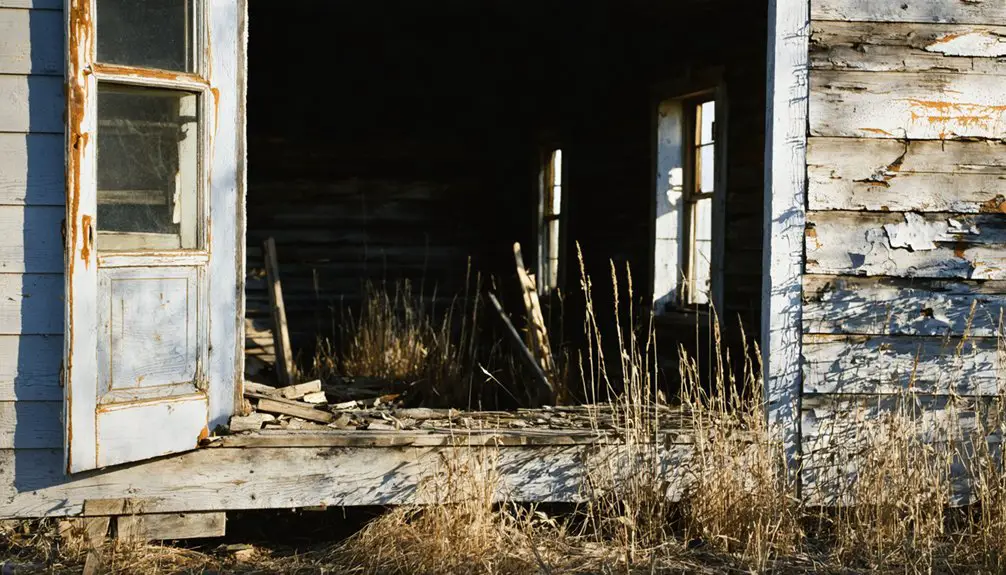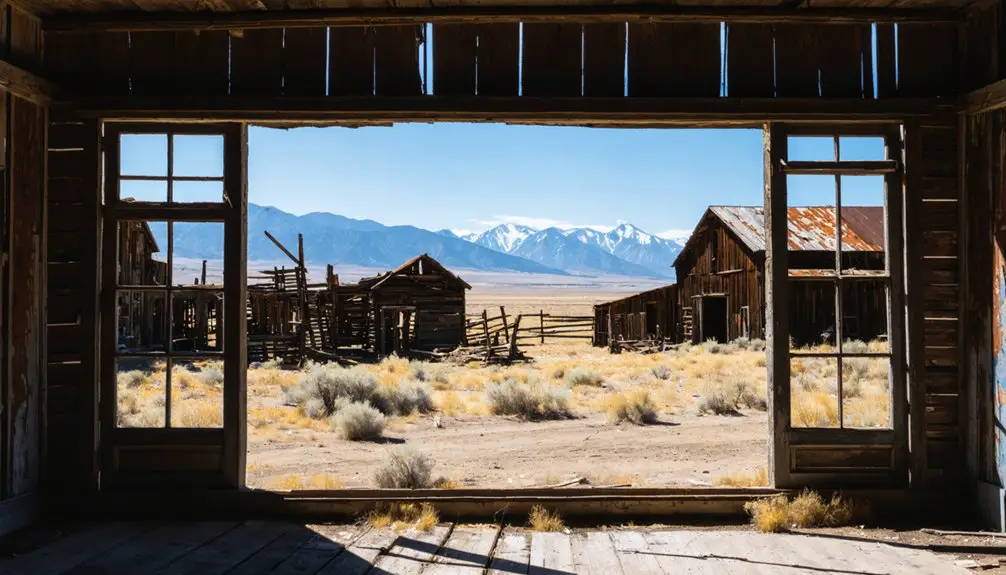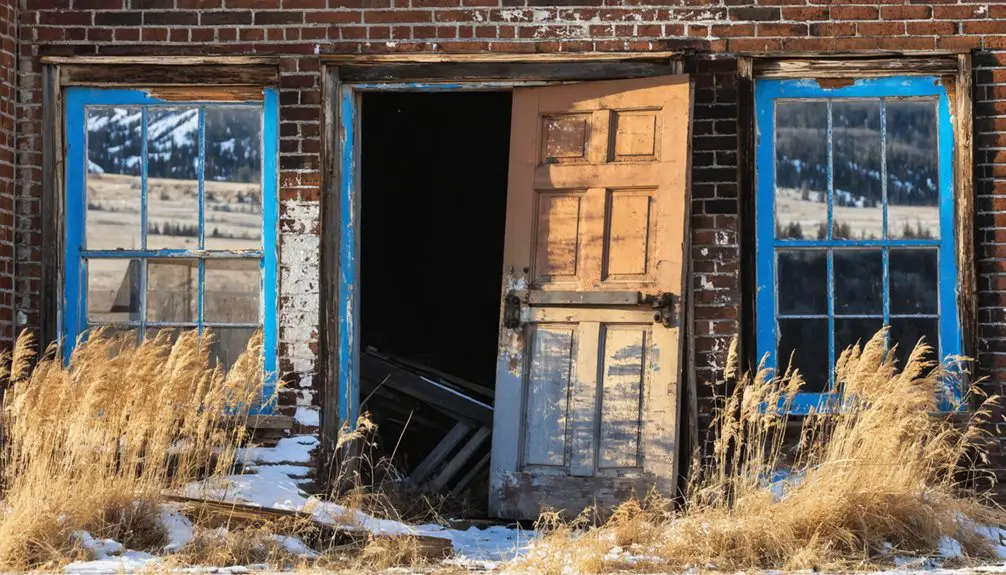You’ll find Silesia, a former farming settlement established in the early 1900s, located 11 miles south of Laurel, Montana. Unlike many Montana ghost towns, Silesia’s story isn’t about mining – it’s about homesteading, particularly by Volga German immigrants who transformed the semi-arid landscape into productive farmland. Today, while most buildings stand abandoned, the local bar and grill remains as the sole business, keeping alive a fragment of this historic agricultural community’s spirit.
Key Takeaways
- Silesia began as an agricultural settlement in early 1900s, driven by homesteading opportunities and Volga German immigrants who developed the farmland.
- The town experienced decline after mining operations became unprofitable following the 1893 repeal of the Sherman Silver Purchase Act.
- Only one commercial building remains active today—a bar and grill established in 2002 that serves as the community hub.
- The town is accessible year-round, located 11 miles south of Laurel, with spring and fall offering the best visiting conditions.
- Historic wooden structures and abandoned buildings showcase the town’s agricultural roots and modest business district from its prime years.
A Farming Settlement’s Origins

While many western settlements emerged from mining or railroad development, Silesia, Montana took root as an agricultural community during the early 1900s homesteading boom.
You’ll find that settlers, drawn by Montana’s unique rainfall patterns and fertile soil, established farms using dryland farming techniques suited to the semi-arid environment.
These pioneering families faced significant settlement challenges as they claimed free government land under federal homesteading laws.
Unlike the bustling mining towns that often saw populations reach 1,500 residents during gold rushes, Silesia maintained steady, modest growth through farming.
You’d have seen them working tirelessly to improve their plots, building homes and cultivating crops to establish legal ownership.
Their European farming traditions proved valuable as they adapted to Montana’s climate.
Through cooperative efforts and shared resources, they created a thriving community centered on small-scale family farms, contributing to Montana’s growing agricultural economy. The settlers’ arrival came decades after the Louisiana Purchase Treaty had secured this territory for American expansion and settlement.
Life in Early Silesia
Three distinct waves of Volga German immigrants shaped early life in Silesia, Montana during the early 1900s.
You’d find these hardy settlers transforming the arid landscape into productive farmland through irrigation projects like the Huntley Project, primarily focusing on sugar beet cultivation and cattle ranching.
Life centered around faith and heritage, with both Evangelical and Catholic churches serving as cornerstones for community gatherings.
Faith and tradition anchored Silesia’s Volga German community, as their churches became vital hubs for both worship and social connection.
You’d witness cultural traditions from the old country thriving through festivals, shared meals, and German-language services.
The 4,766 Volga Germans who called Montana home by 1920 built sturdy farmhouses and barns reminiscent of their European roots.
Despite harsh winters and isolation, they maintained strong social bonds through church activities and mutual support, gradually adapting their farming techniques to Montana’s challenging climate.
Like other settlers who followed the Mullan Road westward, these immigrants helped establish vital transportation routes connecting their new communities.
From Bustling Hub to Quiet Streets
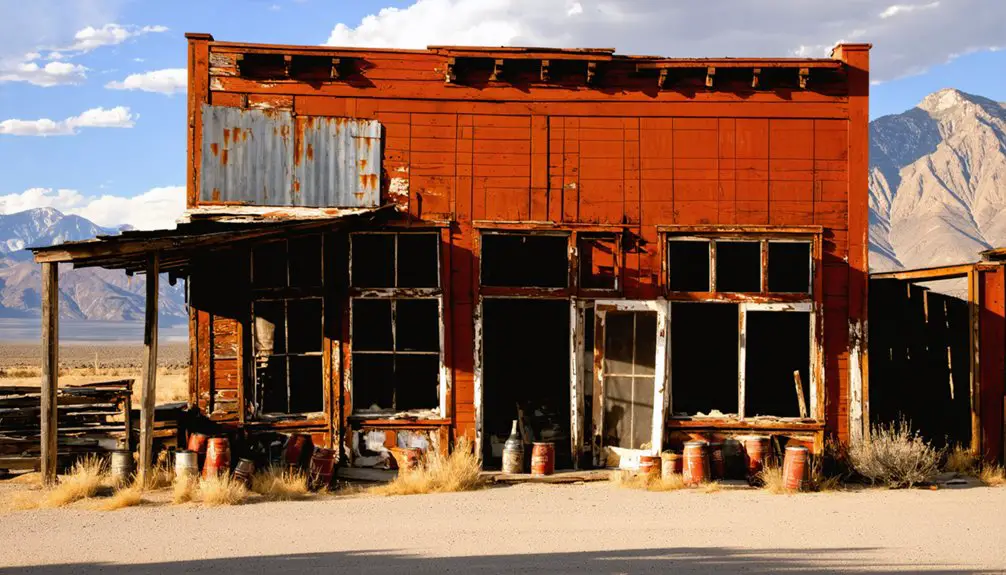
The bustling agricultural community of Silesia underwent dramatic changes as the region’s mining economy collapsed in the late 1800s.
Like the famous Virginia City settlement, Silesia once represented Montana’s economic promise during its peak years.
Many towns across Montana experienced drastic population swings from a few hundred to several thousand residents during the height of mining operations.
You’ll find that the devastating impact of falling silver prices, particularly after the 1893 repeal of the Sherman Silver Purchase Act, triggered a severe population decline throughout the area.
As mining operations became less profitable and ore yields diminished, Silesia’s residents began moving away to seek opportunities elsewhere.
The town’s mining legacy lives on through deteriorating structures and abandoned properties, while its once-active streets fell silent.
Schools, churches, and businesses shuttered their doors as the community could no longer sustain them.
Today, nature slowly reclaims the landscape, with Montana’s harsh weather steadily eroding the remaining buildings, transforming this once-thriving hub into a quiet monument to the American West’s boom-and-bust cycle.
Architectural Legacy and Present State
Unlike Montana’s famous mining ghost towns with their elaborate commercial facades, Silesia’s architectural legacy reflects its humble agricultural roots through simple wooden structures and utilitarian design.
Today, you’ll find a mix of preservation challenges and adaptive reuse, with most buildings constructed using basic wood-frame techniques typical of rural Montana settlements.
- The iconic one-room blue schoolhouse, once converted to a residence, sadly burned down, marking the loss of one of Montana’s last such structures.
- A bar/grill remains operational, standing as the town’s sole active commercial building.
- The abandoned post office and general store showcase the settlement’s modest business district.
Unlike Bannack’s restored boardwalks and false-front architecture, Silesia’s architectural features remain largely unpreserved, though the roads are still accessible.
The Last Remaining Business
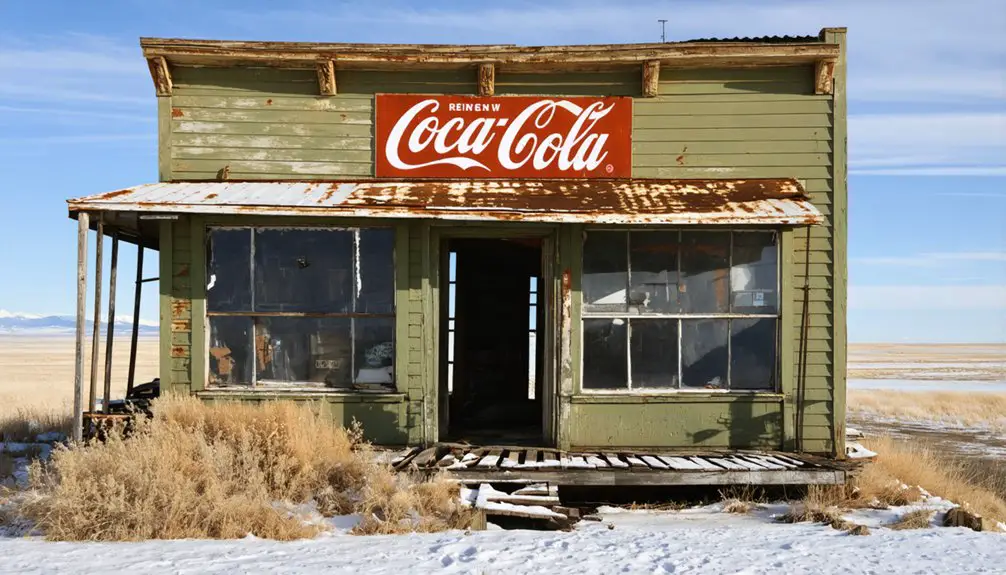
Maintaining its status as Silesia’s commercial lifeline, a solitary bar and grill establishment persists where other businesses have long since shuttered their doors. Since 2002, when the post office and general store closed, this lone establishment has served as the town’s primary community hub, catering to both locals and travelers passing through.
You’ll find this business carries more than just commercial weight – it’s a crucial social anchor in what’s become largely a bedroom community for Laurel and Red Lodge. Much like Bannack’s historic Skinner Saloon, this establishment serves as the town’s central gathering spot.
While Silesia’s farming roots once supported various enterprises, including a schoolhouse and general merchandise, business continuity now rests solely with this establishment. The well-maintained road access helps sustain its operations, drawing occasional tourists and preserving one of the last tangible connections to Silesia’s more vibrant past.
Montana’s Agricultural Ghost Towns
Silesia’s story mirrors countless other agricultural ghost towns scattered across Montana’s vast landscape. Like many frontier settlements, these towns emerged during the homesteading era, serving as essential hubs for farming communities until agricultural decline took hold.
You’ll find that community resilience often centered around shared spaces like general stores, churches, and social halls, where rural families gathered to maintain their connections. Unlike mining towns that relied on gold-bearing quartz, agricultural settlements depended on fertile soil and favorable weather conditions.
Like the Garnet Mountains settlements to the east, many of these towns were situated at high elevations that posed unique farming challenges.
- Transportation played a significant role – towns thrived near railroads but faltered when routes changed.
- Environmental challenges, including harsh winters and limited growing seasons, tested farmers’ resolve.
- The shift to mechanized farming and corporate agriculture squeezed out smaller operations.
- Young people moved to urban areas, leaving aging populations and diminishing community importance.
These agricultural communities faced multiple pressures that ultimately led to their abandonment, from changing economic landscapes to environmental constraints.
Exploring Modern-Day Silesia

When you visit modern-day Silesia, you’ll discover a mix of preserved ruins and remodeled buildings that tell the story of this central Montana ghost town.
You can walk or drive along the original Montana and Main Street layouts, though you’ll need to respect private property boundaries that now dominate the area.
While some visitors hope for ghostly encounters, the real treasure lies in the visible remnants of frontier life.
You’ll find weathered structures that have endured Montana’s harsh elements, though safety concerns mean you shouldn’t enter unstable buildings or collect historical artifacts.
Like many sites documented in Ghost Towns of Montana, this location provides a fascinating glimpse into the region’s past.
For the best experience, look for interpretive signs that explain the settlement’s significance, and consider joining guided tours when available.
Local Stories and Community Memory
The rich tapestry of local stories from Silesia reflects both the triumphs and darker moments of Montana’s frontier history.
You’ll find tales of vigilante justice, community gatherings at the old schoolhouse, and legends that still echo through the remaining buildings.
The town’s darkest chapter involves the school segregation scandal, where Indian children were denied education access.
Today, these local legends live on primarily through oral histories, as many physical landmarks have succumbed to time and weather.
- The Second Banic Cemetery holds over 60 souls, their wooden fences meant to contain wandering spirits
- Tales of Sheriff Plumber and the Innocents gang showcase frontier justice in nearby communities
- The bar/grill serves as the last gathering spot for storytelling and community connection
- School segregation stories remind visitors of past social struggles and injustices
Preserving Rural Montana Heritage
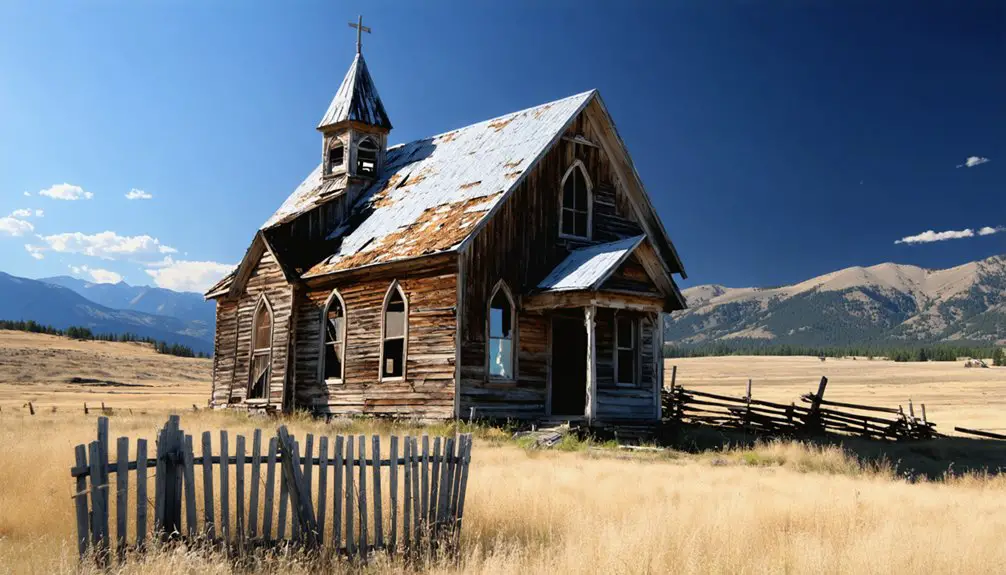
Montana’s commitment to preserving its rural heritage remains evident through strategic funding initiatives and community-driven projects. Through programs like RMRH, you’ll find substantial support for restoring historic properties, with grants ranging from $10,000 to $100,000.
Yet heritage funding challenges persist, as demonstrated by a $12.4 million shortfall in conservation proposals in 2019.
Despite increased preservation efforts, Montana faced a staggering $12.4 million deficit in heritage conservation funding requests during 2019.
You can see the impact of these preservation efforts across the state, from the revitalized town hall in Ekalaka to Philipsburg’s restored facades.
The Montana SHPO’s cultural resource database tracks over 100,000 historic sites, helping protect your community’s legacy. While only six percent of the state’s land has been surveyed, these documented resources serve as essential tools for balancing preservation with development, ensuring Montana’s rural character endures for future generations.
Planning Your Visit to Silesia
You’ll find Silesia easily accessible by 2WD vehicle, located just 11 miles south of Laurel in Carbon County, Montana.
While services are limited, the local bar and grill remains open for food and drinks, though you’ll want to plan ahead since it’s the only operating business in town.
Year-round visits are possible thanks to suitable road conditions, but spring and fall offer the most comfortable temperatures for exploring this semi-desert environment.
Getting There and Around
Situated 11 miles south of Laurel in Carbon County, Silesia ghost town remains accessible via well-maintained 2WD roads connecting to Interstate 90. Similar to Bannack State Park, Silesia retains many of its original structures for exploration. You’ll need your own vehicle to explore this remote location, as no public transit serves the area.
While navigation can be tricky due to limited signage, you can find the site at coordinates 45°33′21″N 108°50′12″W.
- Pack offline maps and GPS devices, as mobile coverage isn’t reliable
- Consider weather conditions, especially in winter when snow affects accessibility
- Plan your parking near the active bar/grill – it’s informal but convenient
- Bring appropriate footwear for walking between scattered historic buildings
Once you’ve arrived, you’re free to explore the ghost town on foot, but remember to respect private property boundaries while discovering Silesia’s abandoned structures and historic sites.
Best Time to Visit
When planning a visit to Silesia ghost town, late spring through early fall offers the most reliable conditions for exploring this historic settlement.
You’ll find hot, dry summers ideal for outdoor exploration, with the bar/grill open year-round for refreshments. While winter visits provide solitude, cold temperatures and potential snow can limit accessibility despite good road conditions.
Consider timing your visit during Montana’s peak tourism season (Memorial Day through Labor Day) to combine your Silesia exploration with regional activities in nearby Laurel and Red Lodge.
You’ll want to pack layers regardless of season due to temperature fluctuations, and bring sun protection for summer visits.
Remember that local amenities are limited to the bar/grill, as the post office and general store have been abandoned since 2002.
Where to Eat
Dining options in Silesia remain limited to a single operating bar/grill, which serves as the town’s sole remaining business establishment since the early 2000s.
For local cuisine beyond this casual spot, you’ll need to venture to nearby towns like Laurel (11 miles north) or Red Lodge, where you’ll find more diverse dining choices.
When planning your visit, consider these dining tips:
- Pack snacks and water for exploring the ghost town area
- Check seasonal operating hours of the bar/grill before your trip
- Visit Laurel or Red Lodge for full-service restaurants and cafes
- Consider booking accommodations with meal options in neighboring towns
The bar/grill offers typical American fare in a rustic setting that complements Silesia’s ghost town atmosphere, making it part of the authentic local experience.
Frequently Asked Questions
Are There Any Documented Paranormal Activities or Ghost Sightings in Silesia?
While ghost stories swirl around nearby towns like Billings and Anaconda, you won’t find documented spectral sightings in Silesia itself. Your best haunted encounters are at surrounding locations like Gunslinger Gulch.
What Was the Peak Population of Silesia During Its Most Active Period?
You won’t find a documented peak population for this ghost town’s history, as no reliable records exist. While the settlement continued into modern times, its peak numbers remain unknown.
Does Anyone Still Live Within the Official Boundaries of Silesia?
Like a ghost from its mining past, you won’t find any current residents within Silesia’s official boundaries today. Despite its historical significance, the town stands empty, preserved only for occasional visitors.
Which Year Was the Post Office and General Store Officially Closed?
You’ll find the post office closure occurred on August 16, 1963, while records don’t specify the general store’s exact closing date, though it’s known to have shuttered shortly after postal services ended.
Are There Any Annual Events or Gatherings Still Held in Silesia?
Like an empty Instagram feed, you won’t find any annual gatherings or local traditions still happening in this ghost town. Historical records and current event calendars show no organized events taking place there.
References
- https://www.youtube.com/watch?v=8DRaKMLZvcs
- https://avrextravel.com/montana-ghost-towns/
- https://mhs.mt.gov/Shpo/docs/CBCoDrivingTour.pdf
- https://visitmt.com/things-to-do/ghost-towns
- https://www.ghosttowns.com/states/mt/silesia.html
- https://en.wikipedia.org/wiki/History_of_Montana
- https://www.montanaliving.com/blogs/destinations/explore-montana-ghost-towns
- https://theriver979.com/montana-ghost-towns/
- https://www.mountain-home.com/blog/vacation-planning/guide-montana’s-ghost-towns
- https://www.youtube.com/watch?v=d5TXZ_WsxPM
